Chapter 7
Schedules
Schedules of a parametric model provide the most immediate return of information from the data inherent in the model. With the Autodesk® Revit® MEP 2013 platform, you can create schedules that are useful not only for construction documentation but also for data management, for object tracking, and even for design decision-making tools.
By building a model, you can look at it from many angles or viewpoints. Schedule views are simply another view of the model. Instead of looking at the physical elements that represent the design, a schedule allows you to view the data within the components in an organized and easy-to-manage format. Using schedules for data management is one way to increase efficiency, accuracy, and coordination within your Revit project. You can edit the properties of many objects quickly without having to locate the objects in the model.
Revit schedules can provide you with an accurate account of the objects that are being used in your project model. The ability to track and manage objects can help with cost estimation and material takeoff. With this information readily available, you have the power to make decisions that affect cost and constructability.
Harnessing the power of creating schedules in a Revit MEP 2013 project can help you reap the benefits that come with easy access to any model or project information.
In this chapter, you will learn to do the following:
- Use the tools in Revit MEP 2013 for defining schedules and their behavior
- Schedule building components
- Create schedules for design and analysis
- Schedule views and sheets for project management
Defining Schedules
Mastering the scheduling tools in Revit MEP 2013 will enable you to easily extract any information from your projects. Schedules can be created and used on any of your Revit projects to establish consistency on construction documents and ease of data management for specified model objects.
Although there are different types of schedules, depending on their use and the items with which they are associated, the tools for creating a schedule in Revit MEP 2013 are similar for whatever type of schedule you are creating. Because schedules are essentially a view of the model, the tools are located on the View tab of the ribbon. Figure 7.1 shows the different types of schedules that can be created by clicking the Schedules button.
Figure 7.1 Schedule types

Clicking the View List or Sheet List option will take you directly to the View List or Sheet List Properties dialog box, where you can begin creating your schedule. Clicking the Schedule/Quantities or Material Takeoff option will take you first to a dialog box that allows you to select the Revit object category that you want to schedule. The Note Block option takes you to a dialog box where you can select the annotation family that you want to schedule.
In the New Schedule dialog box, you can define whether you are creating a schedule of building components or a schedule key. You can also set the project phase of the schedule view. The project phase is an important property of schedules because only the objects in the model that belong to the same phase as a schedule will appear in that schedule. The name that you give your schedule is what will appear in the main header of the schedule when it is placed on a drawing. If your drafting standards dictate that the text should be in all capital letters, you will need to retype the name even if it is correct. From the Filter list pull-down you can filter the object categories you can schedule. The pull-down is the same as the one in the Visibility/Graphic Overrides dialog box. This allows you to select items that are not MEP objects and may not even exist in your model. Note: In 2012 and all prior releases this filter option was a check box called Show Categories From All Disciplines. Figure 7.2 shows a sample of the New Schedule dialog box with settings to build a Spaces schedule.
Figure 7.2 Sample schedule settings
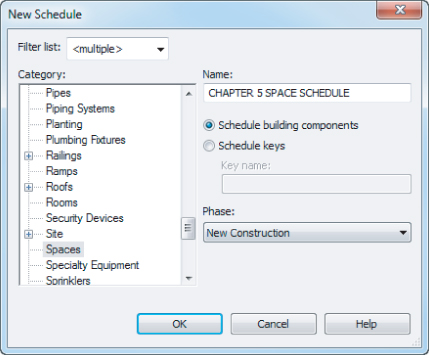
One of the choices is to create a Multi-Category schedule. This type of schedule is for objects that are in different categories but have common parameters. Figure 7.3 shows an example of a Multi-Category schedule. Notice that the Finish Color parameter is used in the schedule even though not all objects have that parameter.
Figure 7.3 Sample Multi-Category schedule

Once you have established the initial settings and chosen a category, clicking OK will open the Schedule Properties dialog box. This dialog box has five tabs across the top that have settings to define the behavior and appearance of your schedule. When scheduling Space or Room objects, there is an additional tab for building an embedded schedule within the schedule you are creating. It is good to move through the tabs sequentially, establishing the settings in each tab before moving to the next. The first two tabs let you determine what information will be scheduled, while the last three enable you to control how the data will be displayed and the graphical appearance of the schedule when placed on a drawing.
The Fields Tab
The Fields tab of the Schedule Properties dialog box contains many tools for choosing the information that will appear in a schedule. Figure 7.4 shows the Fields tab of a newly created Space schedule.
Figure 7.4 Fields tab of the Schedule Properties dialog box
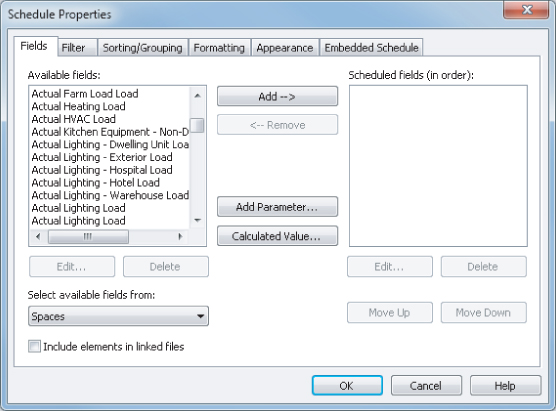
The check box in the lower-left corner allows you to schedule items that are in any files that are linked into your project. The Available Fields list on the left side of the dialog box contains all the parameters that can be scheduled for the chosen category. The Edit and Delete buttons below the list become active only when you select a project or shared parameter that you have created. Only project parameters that are not shared parameters can be deleted.
You can use the drop-down list in the lower-left corner to change the list of available fields to parameters from another category. This is primarily for Space and Room schedules, because the two objects are essentially the same thing. You cannot select fields from Mechanical Equipment if you are creating a Lighting Fixture schedule, for example.
To establish the columns in your schedule, you simply select the parameter from the Available Fields list and click the Add button at the top center of the dialog box. This will place the chosen parameter in the space on the right side of the dialog box. Another way is to simply double-click the parameter you want to add. Each parameter added to the schedule will be a new column, and the order in which they appear in the list determines the order of the columns in the schedule, from left to right. Once you have added a parameter to the schedule, you can use the Move Up and Move Down buttons to set the order. These buttons become active only when you select a parameter from the Scheduled Fields list on the right.
The Remove button at the top center allows you to remove a parameter from the schedule. This is not the same thing as deleting a parameter. Using either of the Delete buttons will remove the selected parameter from your project and any objects in your project.
If you want to schedule information about the chosen category, and a parameter does not exist that contains that information, you can click the Add Parameter button at the center of the dialog box. Clicking this button activates the Parameter Properties dialog box, where you can choose the type of parameter and its properties. The check box in the lower-left corner of the Parameter Properties dialog box is selected by default, and it is grayed out to ensure that the parameter you create will be added to all the objects in the category you are scheduling. Once you have created a parameter, it will automatically be added to the schedule.
Revit schedules have the ability to perform calculations on the data within the parameters that are included in a schedule. This information will then appear as a unique column in the schedule. To create a calculated value column in your schedule, click the Calculated Value button at the center of the Schedule Properties dialog box. Give the value a descriptive name so that when it is seen in the list or schedule, its purpose will be clear. You can create a formula by including parameters in a mathematical equation, or you can calculate a percentage.
The percentage calculation will return the percentage of a specific parameter as it relates to the project as a whole. Figure 7.5 shows the settings for percentage calculation of the volume of Space objects and the resulting column in the schedule.
Figure 7.5 Percentage calculation in a schedule
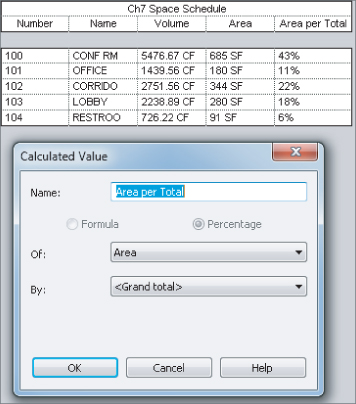
When creating a calculated value based on a formula, it is important to use the proper Discipline and Type settings that coincide with the result of the equation. You will receive a warning stating that the units are inconsistent if the result does not match. Revit is case sensitive when it comes to typing in parameter names, so as you write your formula, it is crucial that you type the parameter name exactly. The small button next to the Formula field allows you to pick the parameter from a list and inserts it into your formula to ensure proper spelling and capitalization. A good rule of thumb is to be consistent with all your parameter names.
Once you have created a calculated value, it automatically appears in the Scheduled Fields list. If you use the Remove button to remove a calculated value from the schedule, it will be deleted from the project. You can use multiple operators and multiple parameters to create complex formulas if necessary. One example of a simple formula for Space objects is to divide the volume by the area to determine the ceiling height, as shown in Figure 7.6. This formula works only because the Space objects have an upper limit set to the level above, and the ceiling objects are set to Room Bounding, thus defining the volume of the spaces.
Figure 7.6 Space schedule with a calculated value for Ceiling Height
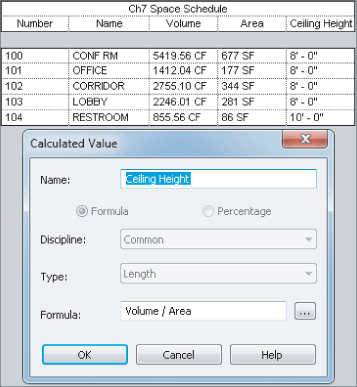
The Filter Tab
The next tab in the Schedule Properties dialog box is the Filter tab. The settings on this tab allow you to filter out unwanted items in your schedule. You can set certain criteria for parameter values that objects in the schedule category must meet in order to be included in the schedule. This is very useful when scheduling a category that has many unique types of items, such as the Mechanical Equipment category. For example, if you wanted to create a Pump schedule, you would have to schedule the Mechanical Equipment category. Without applying a filter to your schedule, all items categorized as Mechanical Equipment would show up in your schedule.
You can apply up to four conditions that an object must meet to make it into the schedule. To set a condition for a parameter, that parameter must be included in your schedule. If you want to use a parameter for filtering but do not want it to show up in your schedule, you have the option of hiding the column of the unwanted parameter under the Formatting tab. There are some parameters (such as Cost, Family, and Type) to which you are not able to apply conditions.
Figure 7.7 shows a sample of a Mechanical Equipment schedule without any filter conditions applied to it.
Figure 7.7 Sample Mechanical Equipment schedule
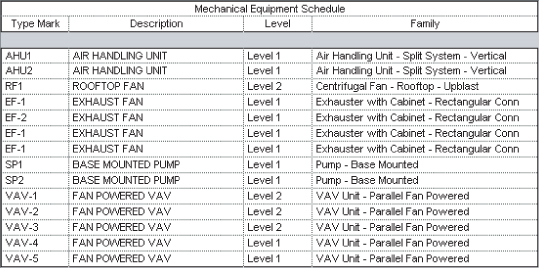
To turn this into a Pump schedule, you would apply the Filter settings shown in Figure 7.8. Notice the many options for filter rules that can be used to narrow down the qualifying objects. Using these conditions in combination with certain parameters gives you a very powerful tool for scheduling exactly the objects you want.
Figure 7.8 Filter settings for a Pump schedule
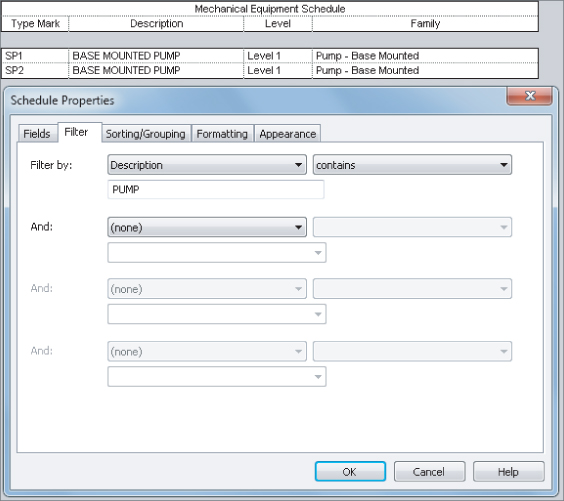
As items are brought into your model, they will automatically appear in a schedule of their category as long as they meet the filter criteria. Remember that if you filter by a parameter, an object may not have a value assigned, so you should input data into the parameter when the object is brought into your project. This will ensure that your schedule is showing all that it should.
As mentioned earlier, another option for filtering a schedule is to set the schedule phase. The different options for the phase filter of a view can be applied to schedule views in the same way that they are applied to model views. So if you were to set the phase of a schedule view to New Construction, and the phase filter to one that shows only New Construction, no items from any previous phase would appear in the schedule. You can select the phase from the New Schedule dialog box shown in Figure 7.2. There is no way to go back to that dialog box once you proceed, but you can change the phase of the schedule at a later time from the Properties palette.
The Sorting/Grouping Tab
The Sorting/Grouping tab of the Schedule Properties dialog box is where you can determine the order of the objects in a schedule and group like items together. You can assign up to four group conditions and provide a header or footer for each group. Sorting can be done based on parameters that are used in the schedule. When you sort by a particular parameter, all the objects in the schedule that have the same value for that parameter will be listed together.
Figure 7.9 shows a sample Lighting Fixture schedule that has been sorted by the Type Mark parameter. Notice that each instance of the different fixture types is listed in the schedule and that the Count column on the far right of the schedule confirms this.
Figure 7.9 Sample Lighting Fixture schedule
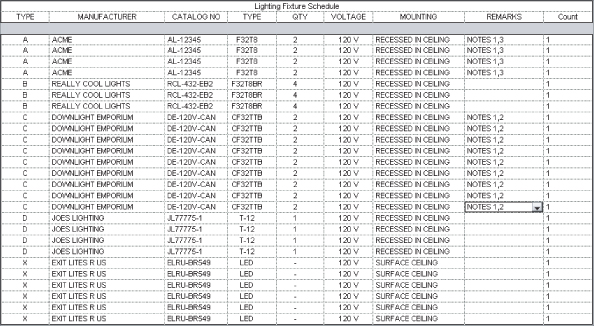
A schedule will list each instance of the objects by default. To group items together that have the same parameter values, you need to deselect the box in the lower-left corner of the Sorting/Grouping tab of the Schedule Properties dialog box. Figure 7.10 shows settings for the same Lighting Fixture schedule, where the Itemize Every Instance box has been deselected. Notice that each type of lighting fixture is listed only once, because the schedule is set to sort by fixture type. The Count column now indicates the total number of each type of fixture. The Grand Totals check box has also been selected to give a total number of lighting fixtures at the bottom of the schedule.
Figure 7.10 Lighting Fixture schedule sorted and grouped by type
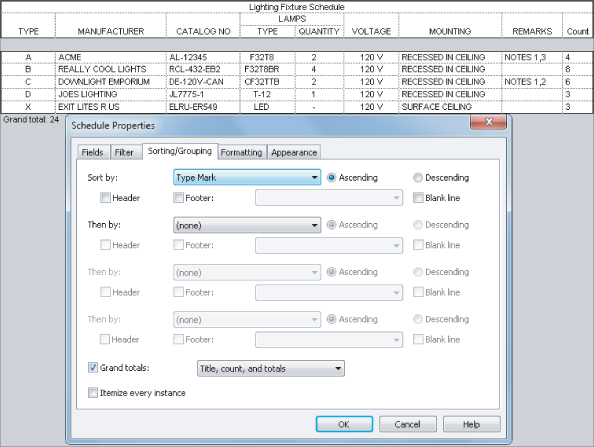
You can use the Sorting/Grouping settings with combinations of parameters to organize your schedules so that you can read the data within them easily. Figure 7.11 shows the Lighting Fixture schedule again, with settings to sort first by the Manufacturer parameter and then by the Type Mark parameter, with a footer to indicate the total number of fixtures per manufacturer. The Ascending or Descending button can be used to determine the order of items within a sorted group. Notice that fixture type A is listed before type D within the Acme Lighting manufacturer group because the Ascending option is used.
Figure 7.11 Lighting Fixture schedule with two sorting options
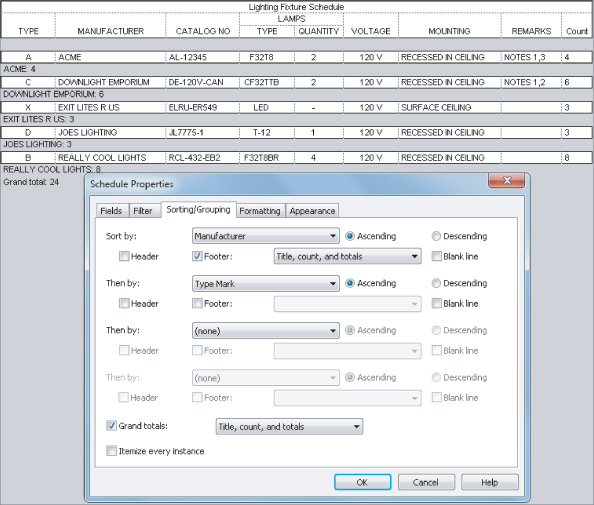
The Formatting Tab
The Formatting tab of the Schedule Properties dialog box has tools for setting how the data will display within a schedule. Each parameter used in the schedule is listed on the left side. When you select a parameter from the list, you can apply the settings available on the right side. You can also apply the settings to multiple parameters by holding down Ctrl or Shift.
The Heading setting establishes the name of the column in the schedule. The parameter name is used by default. Changing the column heading has no effect on the parameter itself, as shown in Figure 7.12, where the Model parameter is used but the column heading is called CATALOG NO. Even if the parameter name is what you want for your schedule column heading, you will have to retype it if you want it in all capital letters. Figures 7.9, 7.10, and 7.11 are also good examples of this practice where the parameter Type Mark has the heading Type.
Figure 7.12 Column heading settings
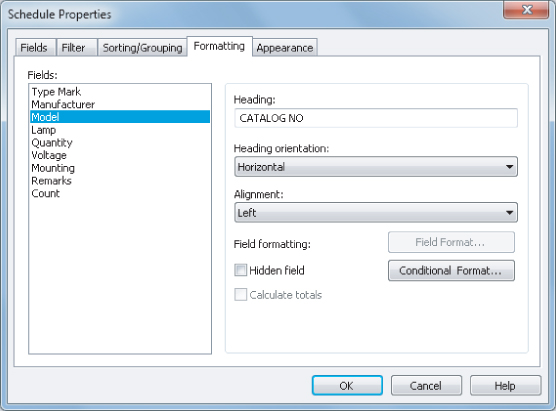
The Formatting tab also has settings for the orientation of the column headings and the alignment of the data within a column. Headings can be either vertical or horizontal, and the data can be aligned to the left, right, or center of a column.
Two additional types of formatting are available, depending on the type of parameter selected. The Field Format button becomes active when you select a parameter that is a measurement. In the Format dialog box that appears when you click the Field Format button, you can change the units and rounding accuracy of the data. You can also choose whether to show the unit symbol in the cell of the schedule. Whatever settings have been established for the project will be used by default. You can deselect the box at the top of the Format dialog box to overwrite the settings within the schedule. Figure 7.13 shows format settings for the Area parameter used in a Space schedule. The unit symbol has been set to None because the schedule column heading indicates the units.
Figure 7.13 Field Format settings
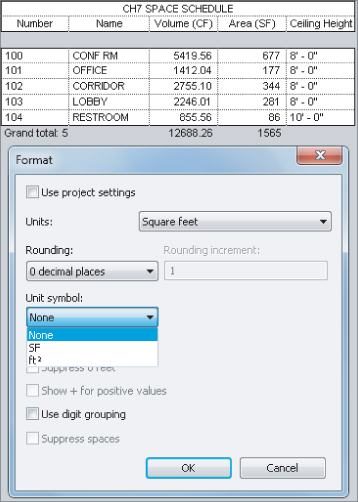
You can change the background color of a cell based on conditions that you apply by using the Conditional Format button. Clicking this button opens a dialog box where you can set a test condition for the value of a parameter and the background color of the schedule cell when the condition is met or not met. Figure 7.14 shows the Conditional Formatting dialog box for a calculated value in a schedule. The Background Color is set to turn red when the result of the calculation does not meet the test condition. The different types of condition test options are shown in the Test drop-down list of the dialog box.
Figure 7.14 Sample Conditional Formatting dialog box
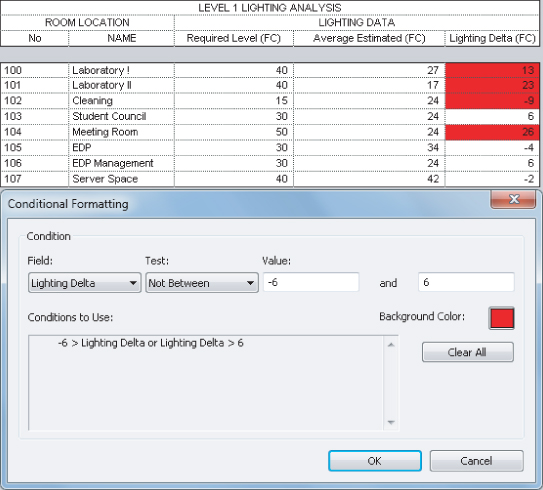
On the Sorting/Grouping tab is an option to display the totals for groups of objects. If you want to show the totals for an individual column, you can select the Calculate Totals box when you select a parameter on the Formatting tab. These totals will not appear if the Grand Totals option is not selected on the Sorting/Grouping tab.
Sometimes you need to include a parameter in a schedule for sorting purposes or for calculations, but you do not want to display the column in your schedule. If this is the case, you can use the Hidden Field check box on the Formatting tab to hide a selected column. This can be very useful because it allows you to hide information without having to remove the information from your schedule. It also allows you to create a schedule with more information than would normally be shown on a drawing, but is useful for calculations or design decisions. When the time comes to put the schedule on a drawing, you can hide the unwanted columns.
The Appearance Tab
The Appearance tab of the Schedule Properties dialog box contains the settings that define how the schedule looks when placed on a sheet. Grid lines and an outline can be chosen from any of the line styles defined in your project. If you do not choose an option for the outline, the line style chosen for the grid lines will be used. The option to include grid lines within the headers, footers, or spacers is also available.
The check box to provide a blank row between the headings and schedule data is selected by default. If this is not how you normally display your schedules, you will have to deselect this box whenever you create a schedule. The Appearance tab also has settings for the text within a schedule, as shown in Figure 7.15. The font and text height that you choose for header text will be applied to all headings, subheadings, and the title of the schedule.
Figure 7.15 Appearance tab of the Schedule Properties dialog box
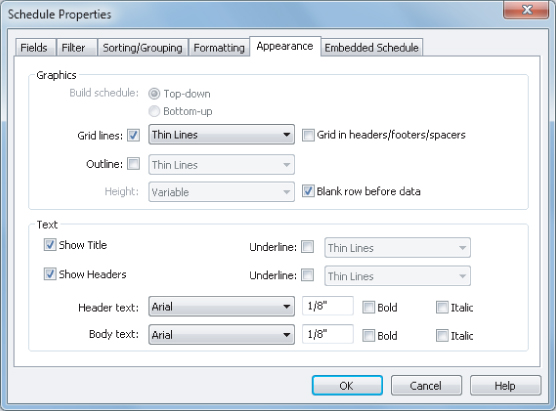
Editing a Schedule
Once you've created a schedule, you can edit it by using the same Schedule Properties dialog box. When you double-click a schedule in the Project Browser, the schedule is displayed in the drawing area. Using the persistent Properties box, you can access the tabs for the Instance Properties list of a schedule view, as shown in Figure 7.16. Each tab has its own Edit button, but clicking any of these buttons will take you to the Schedule Properties dialog box. Whichever button you click from the list will take you to that tab within the dialog box.
Figure 7.16 Schedule view properties
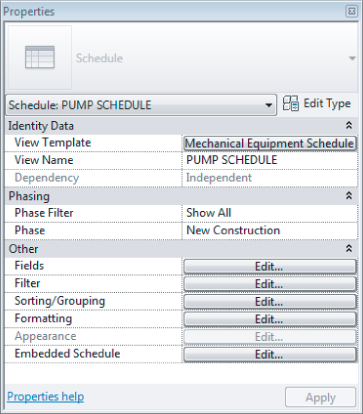
When you access the Schedule Properties dialog box, you can modify the schedule with any of the tools or settings that you would use to create a new schedule. One thing you cannot do is change what is being scheduled. For example, you cannot change a Lighting Fixture schedule to a Lighting Devices schedule, because this is defined in the Family category.
Some of the formatting options that are defined can be modified in the schedule view, without having to access the Schedule Properties dialog box. In the schedule view, you can select anywhere within a column and use the Hide button on the ribbon to hide that column. There is also a Delete button on the ribbon to delete a row in the schedule.
To ensure consistency between all your schedules use View Templates. View Templates will allow you to quickly apply your company standards to a schedule or a group of schedules. To create a new schedule View Template simply right-click a schedule and select Create View Template From View.

When you click in the cell of a column heading, you can change the text of the heading, eliminating the need to access the Formatting tab. You can change the title of the schedule with this method also, although this will change the name of your schedule in the Project Browser. Columns can be grouped together under a common heading by selecting the columns and clicking the Group button on the ribbon. Columns must be adjacent to each other to be grouped. The key to selecting columns for grouping is to hold down mouse button when you click the first column and then drag your cursor to highlight the columns to be included in the group. When you click the Group button, a new blank header will appear above the columns, awaiting input. This is ideal for grouping similar data: locality details, measurements, and so forth (see Figure 7.17). Column groups can be removed by highlighting all the columns within a group and clicking the Ungroup button on the ribbon.
Figure 7.17 Schedule grouping

One of the best features of using schedules in Revit is that you can edit parameter values of objects right in the schedule. If you are changing the value of a type parameter, you will receive a warning letting you know that your change will be applied to all objects of that type when you finish editing the cell. Some cells will turn into a drop-down list when you click them. This lets you select from previously inputted values for that parameter as long as those values are being used in the project. If you click a cell and you cannot edit it, that means that the parameter is a calculated value, it is a parameter of an object within a linked file, or the parameter does not exist in the object.
Because a schedule view is actually a view of the model, you can select a cell in a schedule and click the Highlight In Model button on the ribbon to see where the selected object exists in the model. This will take you to a view of the model, where the object can be seen. You can continue to click the Show button for different views. If you have grouped objects in the schedule and you are not itemizing every instance of the objects in your schedule, then all the selected object types will be shown. This happens because when you select an object in a schedule, you are actually selecting that object, not just a list of the data within that object. The object (or objects) is not just highlighted but actually selected, so you can access its properties or edit it after you close the Select Element(s) In View dialog box.
Some schedules need multiple lines of input within one row. This can be accomplished by pressing Ctrl+Enter when inputting information into a schedule cell or parameter value. Each time you press Ctrl+Enter, you will create a hard return in the value, therefore starting a new line of text. When you are in the schedule view, you will see only the first line of input in the cell. You will not see the other lines of input, so if you need to edit them, you will have to retype all the lines within that cell or parameter value. The multiple lines will display when the schedule is placed on a sheet.
Scheduling Component and System Family Data
Any object type that is placed into a Revit model can be scheduled. This seems like a very generic concept, but if you consider the possibilities that exist, it is easy to see why using a parametric model can be a great benefit to your design processes. Having readily accessible information about the components that make up your design will make coordination and decision making easier and more efficient.
It is important to know what kind of information about model objects can be scheduled, because the types of schedules that you can create for model objects depend on the data within those objects. Some data is inherent in the objects, based on how they are used in the model, such as elevation or location. Most of the data used in component object schedules comes from parameters that are added to the objects either as project parameters or directly in the component-family file as shared parameters. Family parameters cannot be scheduled.
Using the organizational and calculation tools within a Revit schedule can help you get the most from the data within the model components. This section covers some possibilities for scheduling building components.
Mechanical Equipment Schedules
The Mechanical Equipment model category covers a wide range of components. Chillers, water heaters, pumps, rooftop units, fans, and more all fall under the Mechanical Equipment category. As you have seen, using filters makes it possible to create specific schedules for different types of Mechanical Equipment components. The key to success with these schedules is developing a method that makes the filtering easy to use and manage.
When considering the information that is needed in your schedules, you can look at the parameters that already exist in every component and determine whether they can be used in lieu of creating a custom parameter. The Description parameter is one example of a parameter that is in every object. With the ability to change the heading in a schedule, this parameter can be used for any type of descriptive information that is scheduled about your components. You do not need to create a parameter for each type of information to be scheduled. For example, if your Mechanical Equipment schedule for pumps has a column for the mounting type, you could use the Description parameter to convey this information.
Every item that is placed into a model is given a Mark value. The Mark parameter is another useful parameter for scheduling mechanical equipment.
There are certain parameters (Family And Type, Type) that do not appear under the Filter tab as a choice, and therefore cannot be used for filtering objects.
The best reason for using the Mark parameter for Mechanical Equipment schedules is that it makes it easy to filter the schedule for specific items. Figure 7.18 shows a Mechanical Equipment schedule for pumps and the filter settings based on the Mark parameter. This setup allows for having unique Mark values for multiple instances of the same type of component.
Figure 7.18 Pump schedule filtered by the Mark parameter
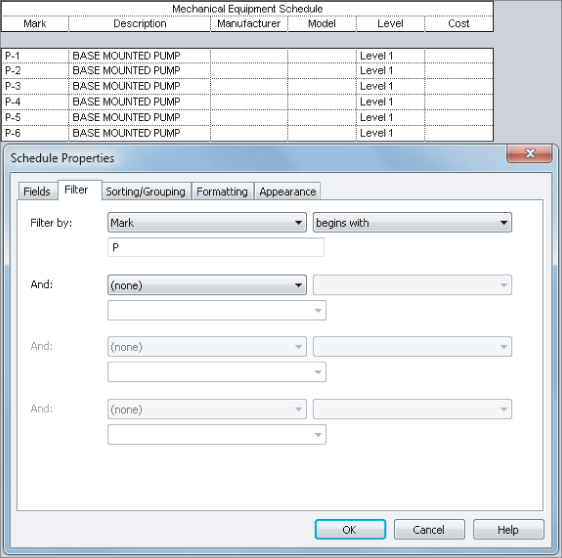
Another way to easily filter your Mechanical Equipment schedules is to create a project parameter called Schedule Type that is applied to the Mechanical Equipment category. You can then assign values for this parameter in order to create schedule filter rules. This may be the preferred method, because the Schedule Type parameter could be applied to all appropriate model categories and would give you a uniform method for filtering schedules.
If you have a schedule with a column for remarks or notes about an object, the Type Comments parameter can be a useful alternative to creating a custom parameter. The value of this parameter can refer to text notes associated with a schedule.
Lighting Fixture Schedules
The Type Mark parameter is a useful way to assign a unique identifier to each fixture type within your project and eliminates the need for a custom parameter. If you use a standard set of fixtures for each design, you might consider naming each family type within your fixture families and using the Type name to identify your fixtures in a schedule. The family type name shows up as Type in the Available Fields list, as shown in Figure 7.19.
Figure 7.19 Family Type option in the Available Fields list
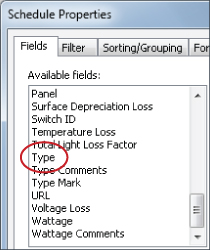
The URL parameter can be used for any component and is particularly useful for lighting fixtures. You can input a link to the cut sheet of a lighting fixture into its URL parameter for quick access to the additional information that a cut sheet provides. Because a manufacturer's website can change at any time, it is not recommended that you provide a link directly to a web page but rather to a downloaded file on your computer or a network drive. Figure 7.20 shows an example of a Lighting Fixture schedule with a URL column. When you click on the URL row, a small box at the right of the end of the URL cell will show up. The cut sheet file opens when you click on that small box.
Figure 7.20 URL parameter used in a Lighting Fixture schedule
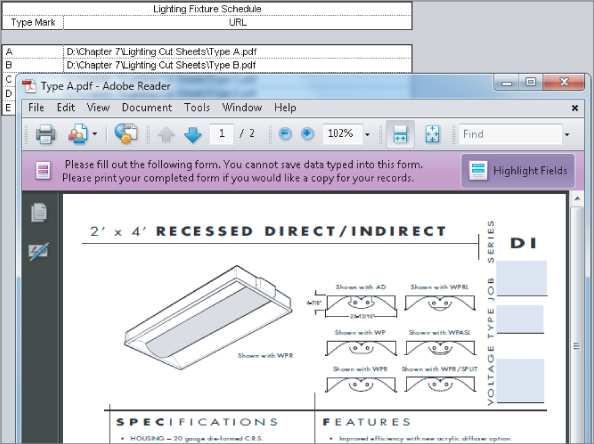
The paths you provide in URL parameters are not relative, so if you share or submit your Revit project file, the links will be inactive unless you also share the cut sheets and you create new paths for the URL parameters.
System Family Schedules
Schedules are useful not only for component objects but for system families as well. Duct, Pipe, Cable Tray, and Conduit schedules can be created for use on construction documents or just for keeping track of quantities and materials.
Duct Schedules
A lot of information can be taken from a ductwork model. How you organize a Duct schedule depends on the type of information you are looking for and what you intend to do with it. Determining the amount of sheet metal for ductwork is one way to utilize the power of scheduling in Revit MEP 2013. Unfortunately, the Material Takeoff option of the Schedules tool on the View tab is restricted to component families. However, with some calculated fields and the right parameters, you can create a schedule that works as a material takeoff.
Figure 7.21 shows a sample Duct schedule with calculated values to determine the total area of material for both round and rectangular ducts. A duct material project parameter was created, and values were manually input for different duct types. The total area for each duct material is calculated at the bottom. This is just a small example of how you can get useful information from your model in schedule format. Keep in mind that because Revit is a parametric modeling tool, as ducts are removed, added, or changed, the schedule will reflect those changes automatically.
Figure 7.21 Sample Duct schedule
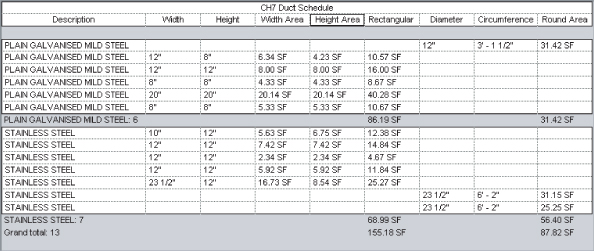
Another type of Duct schedule can help you keep track of what type of duct is used for different air systems. A schedule like this will enable you to see whether any errors have occurred in the model based on design criteria. If all return-air ductwork is to be rectangular, for example, a schedule will quickly reveal any duct that does not meet this requirement.
Pipe Schedules
Creating a custom Material Takeoff schedule for pipe is a little easier than for duct because pipe types can be assigned a material without creating a custom parameter. Figure 7.22 shows a sample Pipe schedule that is organized to show the total length of each pipe size per material.
Figure 7.22 Sample Pipe schedule for a material takeoff
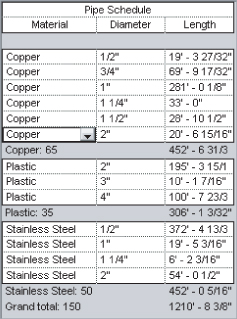
Although cost cannot be used in a calculated value, with this information readily available, you could easily estimate the cost of pipe for your project.
You can create Pipe schedules to input data quickly into the properties of pipes without having to locate each pipe in the model. One example where this may be useful is with pipe insulation. You can create a Pipe Insulation schedule like the one shown in Figure 7.23, which groups pipe insulations by their system types.
Figure 7.23 Sample Pipe Insulation schedule for parameter input

Insulation Thickness is an instance parameter of the new insulation category. You can apply a value to several objects at once by grouping the insulation types and deselecting the Itemize Every Instance box on the Sorting/Grouping tab of the Schedule Properties dialog box. When you input a value for the Insulation Thickness parameter, it is applied to all pipes within that group. Just keep in mind that Insulation is considered a separate object, and pipes that don't have any insulation will not even appear on the Pipe Insulation schedule. For that reason it is best to use two schedules, a Pipe schedule and a Pipe Insulation schedule. From the Pipe schedule you can see and select the pipes that don't have insulation. While the pipes without insulation are still selected, you can apply Insulation from plan view. Once all necessary pipes have insulation, you can manage them from the Pipe Insulation schedule.
Space Schedules
Spaces are typically scheduled to analyze their data to determine the performance of systems. However, creating a Space schedule can also help with model maintenance or quality control. A very simple Space schedule can be a useful tool for removing unwanted or misplaced spaces, reducing the risk of performing analysis of an incorrect model.
Spaces can be placed into a model manually or by using the Place Spaces Automatically tool on the Modify | Place Space contextual tab. The one drawback to the automated process is that Revit will place a Space object in any enclosed area that is bounded by objects defined as Room Bounding and that is 0.25 square feet or larger. This often results in Space objects being placed in pipe and duct chases, or column wraps and other small enclosures. In a large model, it could be time-consuming to search for all the unwanted Space objects, making the automation of space placement seem unreasonable. When these spaces are found, deleting them removes them from the model only. They still exist in the project and could be inadvertently used again or have unnecessary analysis performed on them.
Consider creating a simple Space schedule that will quickly identify any unwanted spaces and allow you to delete them all completely from the project with a few clicks. When you link in an architectural model, one thing you need to do is set the Room Bounding parameter so that it will define the boundaries of your spaces. Placing a space within the same boundaries as a Room object will associate that space with the architectural Room object. So, unless your architect has placed Room objects in areas such as chases or column wraps, you can easily see which of your spaces match up with the rooms.
Figure 7.24 shows the settings for a Space schedule that can be used to eliminate unwanted spaces. The schedule is sorted and grouped by room number so that all spaces without an associated room will be listed together at the top of the schedule.
Figure 7.24 Space schedule
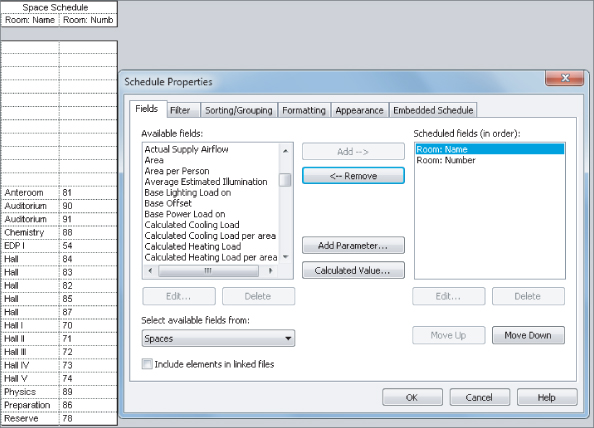
The unwanted spaces can be highlighted in the schedule and then removed from the project by using the Delete button on the ribbon. You cannot use the Shift or Ctrl keys, but you can click and drag your cursor to select multiple rows within a Revit schedule.
The Schedule Properties dialog box for a Space schedule contains an additional tab for creating and managing an embedded schedule. This allows you to create an additional schedule that is set up “inside” your Space schedule. On the Embedded Schedule tab, you can select the box to include an embedded schedule within your Space schedule and choose the model category you want to schedule. When you click the Embedded Schedule Properties button in the lower-left corner, a new Schedule Properties dialog box appears. You can then set up the embedded schedule in the same way you would set up a regular one. The Appearance tab is not available in an embedded schedule because the settings are controlled by the host schedule.
Figure 7.25 shows the Fields tab of a Lighting Fixture schedule that is embedded into a Space schedule. The fixtures in the embedded schedule are sorted and grouped by the Type Mark parameter, and grand totals are shown.
Figure 7.25 Embedded Lighting Fixture schedule settings
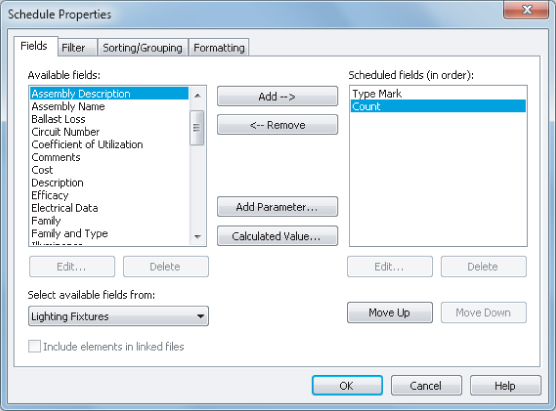
The information within the embedded schedule will be included in the host Space schedule, as shown in Figure 7.26. By creating this type of schedule, you can see how many elements are associated with each space.
Figure 7.26 Space schedule with an embedded Light Fixture schedule
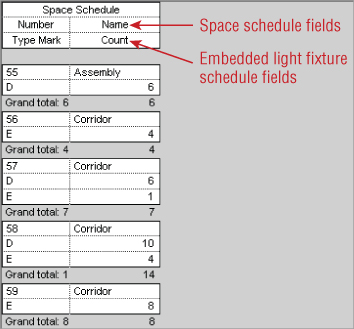
Model Component Schedules
Understanding the basic features of a component schedule will help you begin to develop your own methods for scheduling your Revit projects. Create a simple component schedule by doing the following:
Using Schedules for Design and Analysis
Scheduling building components to provide information on construction documents or to keep track of model components and materials are not the only uses for schedules in Revit. Using schedules to analyze the performance of MEP systems in relation to the building model can help you make design decisions. The ability to see and manipulate the information directly in Revit can improve the efficiency of your design processes.
When it comes to analysis, the focus is mainly on the Space objects in your model. Space objects hold a lot of energy analysis–related information either by direct input, input from third-party analysis, or as a result of the characteristics of components associated with the spaces. Understanding the type of information you can retrieve from spaces during the design process is the key to developing schedules that are most useful to your workflow.
Analysis can be as simple as checking to see whether the components you are using meet the engineering requirements or standards around which you are designing. This often requires that you manually set the requirement information property of your spaces. Selecting each space and accessing its properties to input this information is an inefficient practice.
Schedule Keys
A special type of schedule can be created to improve the process of adding information to your spaces. This is a schedule key, and it allows you to specify values for a parameter based on the value of a key parameter. One example is in lighting design, where a certain lighting level is required for specific types of rooms. A schedule key can be created to associate a specific lighting level value with each space key parameter value. The parameter associated with the key can be included in your Space schedule so that each space can be assigned a key and therefore a required lighting level. The required lighting level could be input manually into the parameter, but using a key ensures accuracy and consistency.
Click the Schedules button on the View tab and select Schedule/Quantities to create a schedule key. When you select the category you want to schedule, the option to create a schedule key becomes available on the right side of the dialog box. You can then choose a name for the key parameter in the Key Name field. A style-based name will automatically be placed in the Key Name field, but you can change it to whatever you want. After you create the schedule, a parameter with this name will be added to all the objects in the category for which you are creating a schedule key. Figure 7.27 shows an example of the settings for a Space schedule key. Notice that the schedule has been named to identify it as a schedule key and not a component schedule.
Figure 7.27 Space schedule key setup

The Key Name parameter will automatically be included in the Scheduled Fields area on the Fields tab of the Schedule Properties dialog box. Here, you can select parameters to which values are assigned based on the key value. In the case of a Space schedule key for lighting levels, the Required Lighting Level parameter is chosen, as shown in Figure 7.28.
Figure 7.28 Space schedule key Fields tab
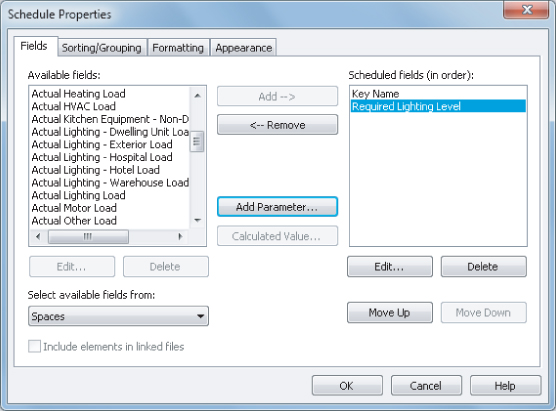
The schedule key is sorted by the Key Name parameter by default. Unless you will be placing the schedule on a drawing, there is no need for any other settings within the Schedule Properties dialog box. The schedule key will start out blank. Click the New button on the Rows panel of the ribbon to add a row to the schedule. You can then edit the name of the key and assign a value to the associated parameter. Repeat the process to create additional rows and build your schedule key. Figure 7.29 shows an example of a Space schedule key for lighting levels.
Figure 7.29 Sample schedule key
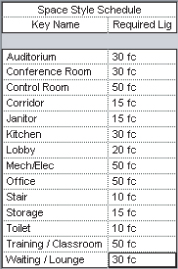
Now that you have created the schedule key, each space has a Space Style parameter that can be assigned a value from the schedule key assigning it a value for the Required Lighting Level parameter. A schedule can be used to assign these values without having to access the properties of each space. When you are editing a key parameter value in a schedule, a drop-down list appears with all the key values, as shown in Figure 7.30.
Figure 7.30 Editing a schedule key parameter
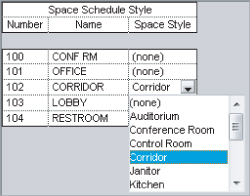
A key parameter can be included in a schedule that is set up for analysis to increase the functionality of the schedule. Additional parameters were added to the schedule shown in Figure 7.30 to determine whether the lighting levels in each space meet the design requirements. A calculated value was added to show the difference between the required level and what is actually occurring in the space. This type of schedule allows you to quickly see the performance of the design components used, and you can adjust parameter values of the spaces to investigate options. Notice in Figure 7.31 that spaces, which have been assigned a Space Style value, have the corresponding Required Lighting Level parameter value from the key.
Figure 7.31 Space lighting level analysis schedule

This same type of schedule can be created for airflow in spaces. The design airflow value can be checked against the actual airflow and the value calculated by a third-party analysis or directly from the Revit MEP 2013 Heating and Cooling Analysis tool.
The ability to see the performance-based data is essential to checking the quality of your design and for making appropriate changes to the design when necessary. Figure 7.32 shows an example of a Duct Airflow schedule that displays the properties related to the performance of the system rather than information about the physical properties of the ductwork.
Figure 7.32 Duct Airflow schedule

Panel Schedules
The ability to create custom Panel schedules was a long-awaited feature that was introduced into Revit MEP 2011. They are not created by using the scheduling tools, but instead are generated by a predefined format redundant in a panel schedule template. There are tools to create a panel schedule template with settings for both the appearance of the schedule and the data that is reported.
Unlike in some earlier versions of Revit MEP that have two separate tools for creating a Panel schedule and viewing and managing circuits, Revit MEP 2013 combines all the functionality into the Panel schedules. This means you will need to create a Panel schedule to view and manage circuits even if you do not intend to use the schedule on your construction documents.
Once you have established panel schedule templates within your project template, they will be available for use on any project. If you want to create a custom Panel schedule, the first step is to create its template. You can find the Panel Schedule Templates tool on the Manage tab:
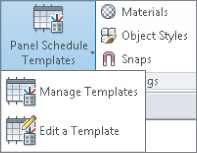
The Manage Templates option gives you access to your panel schedule templates for editing or duplication. Clicking this option activates the Manage Panel Schedule Templates dialog box. The first tab on the dialog box lists any templates in your file. The three types of panel templates that you can create are Branch Panel, Data Panel, and Switchboard. Once you have created a panel schedule template, the Make Default button enables you to establish a selected template as the default. Buttons at the bottom of the dialog box can be used to edit, duplicate, rename, or delete a template.
The second tab of the dialog box allows you to apply a panel schedule template to any panel in your project. When you make changes to your panel schedule templates, you can update the schedules for panels that are using the older version by selecting the panels from the list and clicking the Update Schedules button.
To build a custom template, start by clicking the default template in the list on the Manage Templates tab of the dialog box. Use the Duplicate button at the bottom of the dialog box to copy the default template. Select the newly created template in the list, and use the Edit button to begin customizing your Panel schedule.
All the tools for editing and formatting a panel schedule template are located on the Modify | Panel Schedule Template contextual tab that appears on the ribbon when you click to edit a template. Every panel schedule template has a header area, a circuit table, a load summary area, and a footer. That does not mean that you have to use all four of these areas. You can access the settings for the overall appearance and behavior of a panel schedule template by clicking the Set Template Options button on the contextual tab.
There are three main areas for the overall settings. Figure 7.33 shows the General Settings options. The Total Width setting determines the size of the schedule when placed on a sheet. The height is determined by the row height settings within the schedule. There is no longer a need to adjust column widths after placing a schedule onto a sheet, because the widths are defined directly in the schedule template view. The number of slots shown is determined by the panel family used or defined here in the template options. You can deselect the boxes to remove the header, footer, or loads summary, but the circuit table cannot be removed.
Figure 7.33 General Settings area for a panel schedule template
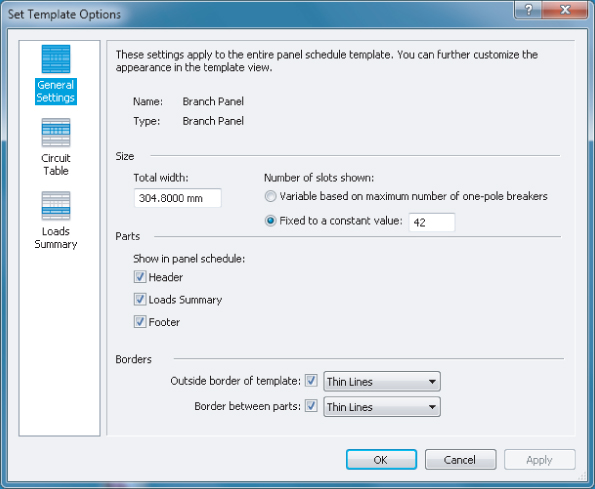
The Circuit Table options allow you to define the format for the columns that display circuit loads. Single-phase panels can be created, and options for the third-phase loads column are available. These columns will appear in the center of your schedule no matter what you do to format the other columns. The values in these columns cannot be edited, and you cannot replace them with another parameter. Now in Revit MEP 2013 you have the ability to show the phase values as either Load or Current.
The Loads Summary options let you set which load classifications will be listed when the loads summary is included in your schedule. All load classifications that exist in your project are shown on the left, and the ones that appear in the schedule are listed on the right. If you choose the option for displaying only those loads that are connected to the panel, all the classifications will move to the Scheduled Loads list. When you create a Panel schedule, only the classifications that are connected will display; however, the loads summary will have blank rows for the unused classifications, as shown in Figure 7.34.
Figure 7.34 Loads summary

The tools on the Modify | Panel Schedule Template contextual tab of the ribbon are the same kind of tools that you would find in a spreadsheet program. You can merge cells, add or delete columns and rows, set the borders and shading of cells, and set the alignment of column data. You can also adjust the font for a cell or group of cells. Many of these tools are also available on a menu that appears when you right-click a cell in the schedule view. You can adjust row and column heights and widths by clicking and dragging the border lines in the schedule view.
The Parameters panel of this tab has a drop-down for selecting a category, and a drop-down for selecting parameters within a chosen category to be placed in a column. You can place unique parameters in individual cells in any area of the schedule except for the circuit table. When you click a cell in the circuit table and select a parameter, that parameter populates all the cells in that column and the corresponding column on the other side of the table. When you click a cell in the Circuit Table area, the only category available in the drop-down will be Electrical Circuits. In other areas of the schedule, you can choose parameters from the Electrical Equipment and Project Information categories.
You can set the units to be used in the circuit table with the Format Unit button on the Parameters panel. There is also a button for creating a calculated value in a cell. This tool works the same way as in a building component schedule. The Combine Parameters button allows you to put multiple parameters in a single cell. It is similar to the tool for building a label in an annotation or tag family. You choose the parameters for a cell, the options for a prefix or suffix, and how the parameters will be separated if necessary.
Using Schedules for Project Management
You can apply the scheduling capabilities of Revit to other areas of your project to facilitate project management and organize construction documents. You can even use schedules as a way to coordinate plan notes and ensure coordination between notes and their callouts.
Sheet List
One of the unique types of schedules available on the Schedules button is a Sheet List schedule. A Sheet List schedule is built with the same tools as a model component schedule, but all the parameters are related to sheets. Creating a Sheet List schedule is useful for managing your project documentation, because the schedule allows you to track what sheets have been created, revised, and checked. You can create custom parameters that apply to sheets for management by other means.
If you are required to submit a list of all the drawings in a submittal package, you can use a Sheet List schedule. Using a Sheet List schedule will ensure that all the sheets created in your project are listed. Some submittals do not require all sheets to be submitted, so a custom parameter that allows you to control what sheets are included in a submittal is a good way to manage your sheet list.
As with most schedules that appear on construction documents, it is a good practice to have two Sheet List schedules in your project: one that has all the parameters that you need for tracking and making changes, and another that is actually included in your construction documents. This keeps you from having to hide and unhide columns when working in the schedule view. Figure 7.35 shows a Sheet List schedule with a parameter for whether a sheet is submitted, and the corresponding Sheet List schedule that appears in the construction documents. The schedule on the bottom is filtered by the Submitted parameter so that only sheets that are selected appear in the list.
Figure 7.35 Sheet List examples
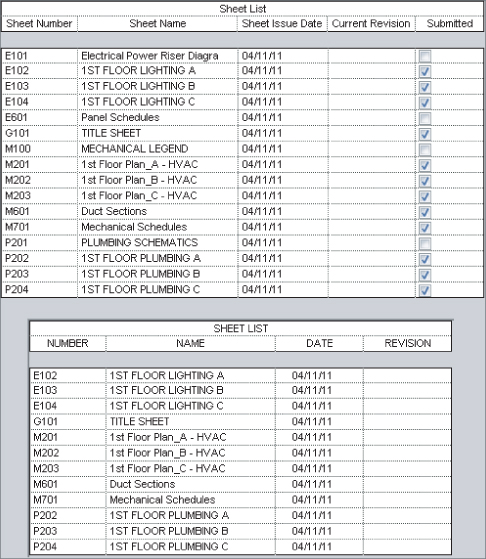
Even though you may have established how sheet views are organized in the Project Browser, it may not meet your requirements for listing the sheets included in a project submittal. You can use a custom parameter to sort your Sheet List schedule in the order you require. You can use a numbering system in combination with the items being listed alphabetically to arrange the sheets in your schedule, as shown in Figure 7.36.
Figure 7.36 Sheet List sorted in order
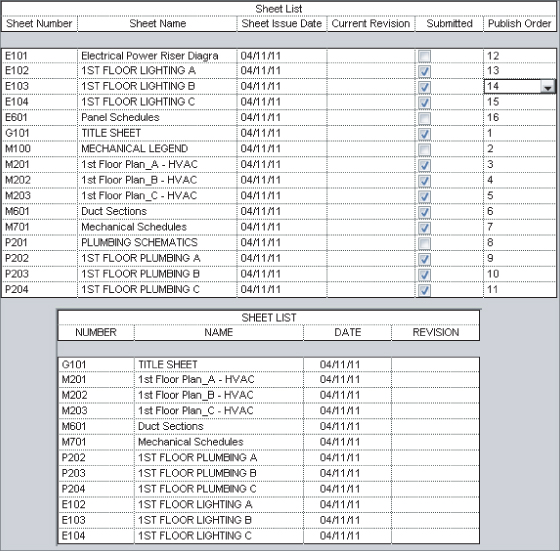
Notice that different decade groups are used for each discipline so that sheets can be organized within a discipline. This allows the electrical site plan to be listed before the plan sheets, for example, without having to provide a unique number for each sheet.
View List
A View List schedule is another unique type of schedule that can be created from the Schedules button on the View tab. Similar to a Sheet List schedule, a View List schedule can help you keep track of the views that exist in your project.
When printing a set of construction documents, you want to be sure that all your views that should be on a sheet have been placed onto the appropriate sheet. Not only will this save you the time it would take to visually inspect each sheet, but it can also save paper and wear-and-tear on your printer.
A View List is constructed with the same tools as a Sheet List, except only parameters that apply to views can be used in the schedule. Unfortunately, not all view parameters can be scheduled, but there are many that are useful for project management. When working in a project that includes phases, a View List can be a useful tool for ensuring that views are set to the proper phase and have the proper phase filter applied.
To create a View List that shows only views that are placed on sheets, you can use a filter. If you use the Sheet Number parameter as a filter with the Does Not Contain rule and leave the value blank, the expected result would be a schedule that shows only those views that are placed on a sheet.

Normally you would apply a filter to remove all the scheduled items that do not meet your filter requirements. However, using these settings will actually remove all views that meet the requirements of the filter, causing your schedule to list all the views that have no value for the parameter.
Note Block
A Note Block schedule is part of an annotation family that is used in your project. Note Block schedules are very useful for managing plan notes on your construction documents as an alternative to keynoting. As note annotations are placed in a view, they can be given a description, and then a Note Block schedule can be created to list the descriptions of each instance of the annotation. Figure 7.37 shows the properties of a note annotation family used for plan notes.
Figure 7.37 Note annotation properties
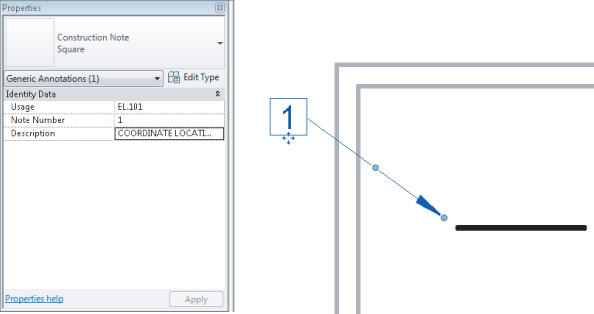
A Usage parameter has been created to determine to which sheet the note belongs. The Description parameter holds the contents of the note. Once a note annotation is placed in a view, it can be copied for each instance or to create the next note in the list.
A Note Block schedule is created by choosing the Note Block option from the Schedules button on the View tab. The annotation family that is used for plan notes is selected to be scheduled. The title of the Note Block should be a description of where the notes are located to make it easy to locate the Note Block schedule in the Project Browser. The Note Number, Description, and Usage parameters are added to the schedule. The schedule is then filtered by the Usage parameter so that only note annotations that appear on a specific sheet will appear in the schedule, and the Usage parameter is hidden. The schedule is sorted by the Note Number parameter.
It is important to establish the Usage parameter value for the first note annotation placed into a view, and then to copy that view whenever a new note is required. Copying the note annotation will ensure that the Usage parameter value is the same for each note in the plan view. The Note Block view and its associated plan view can be tiled so that as you add note annotations to the plan view, you can see them appear in the schedule. The Properties palette gives you instant access to the Description parameter of the note annotation so changes can be made easily.
One benefit of using a Note Block schedule over static text for plan notes is that if you need to change what a note says, you can deselect the Itemize Every Instance option in the schedule to see each unique note; then, when you change the description of the note, it will change for all instances.
Another benefit is that if you need to delete a note, you can delete it from the Note Block schedule, and all instances will be removed from the associated plan view. This ensures that you do not have a note annotation in the plan view that references a note that does not exist in the plan notes. It also eliminates the need for having a note in the notes list with a value of Not Used because the notes can easily be renumbered in the Note Block schedule when a note is removed. Renumbering the notes in the schedule will automatically update the annotations in the plan view.
When you place the Note Block schedule onto a sheet with its associated plan view, you will want to adjust the Appearance settings so that the schedule title and headings are not shown, giving the schedule the appearance of a list rather than a schedule, as shown in Figure 7.38.
Figure 7.38 Note Block plan notes on a sheet
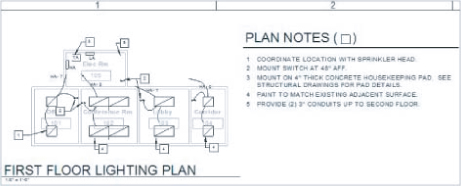
Text was used on the sheet to provide a title for the list of notes. Notice that there is no square symbol for each note number in the list. Unfortunately, you cannot add graphics to a schedule at this time, but the benefits of coordination between the list of notes and the annotations on the plan far outweigh having a square around each number. A square symbol was added to the title as a legend to further clarify to the contractor what the note symbols represent.
The Bottom Line
Use the tools in Revit MEP 2013 for defining schedules and their behavior.
The capabilities of schedules in Revit MEP 2013 can increase your project coordination and the efficiency of your workflow. The ability to track items within a model can help you better understand the makeup of your design.
Master It
The information in schedules comes from information stored within the objects of a Revit model. Explain why editing the data of an object in a schedule will change the properties of the object.
Schedule building components.
Scheduling building components is the primary use of the scheduling tools in Revit. Schedules are used on construction documents to provide additional information about components so that drawings do not become too cluttered.
Master It
Understanding what information can be used in a schedule is important to setting up a specific component schedule within your Revit project. What types of parameters can be included in a schedule? What types cannot?
Create schedules for design and analysis.
Scheduling can go beyond counting objects and tracking their information. You can also create schedules that assist in making design decisions by providing organized analytical information.
Master It
The information stored in Space objects often comes from their relationship with other objects. Some of the data for analysis needs to be input manually. Explain how using a schedule key can assist in adding data to a Space object.
Schedule views and sheets for project management.
The views and sheets within your project can be scheduled, not just the components that make up a model. Specialized schedules for views and sheets are useful for project management.
Master It
A Note Block schedule enables you to list information about annotation families within your project. What are some of the benefits of using a Note Block instead of static text for plan notes?
